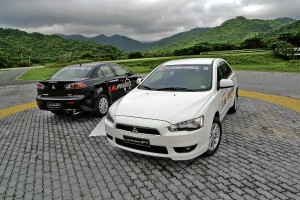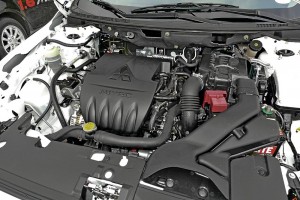Striking looks and fuel efficiency for the new Lancer EX 1.6

SHIBATA: The launch of the new Lancer EX 1.6 completes a formidable compact sedan lineup for Mitsubishi.
Driving down the steep and twisty mountain road that leads to Pico de Loro Cove in Nasugbu, Batangas, it felt more like a victory lap for the new 1.6-liter variant of Mitsubishi’s Lancer EX for the three of us in the car.
The Lancer EX exceeded expectations in a 100-kilometer fuel economy run where teams took the challenge of achieving the highest average fuel consumption while driving from Microtel Mall of Asia in Pasay City to the Shell Station at the junction of Lian and Nasugbu in Batangas via Cavitex, Naic, Indang and Tagaytay.

IN RESPONSE to the green challenge, the new Lancer EX 1.6 was developed to deliver better fuel economy.
After driving so slow and getting clammy inside (yes, we turned the air conditioner off), me and my teammates Ira Panganiban of Power Wheels Magazine and Eric Tipan of Jam 88.3, felt so confident that our 16 kilometers per liter would be more than enough to beat the others.
Only to realize later that our best was not good enough. One team did an even more amazing 17 kpl!
Considering all the eight units are equipped with the 4-speed INVECS II automatic transmission, such average fuel consumption figures are already remarkable when compared to the previous CVT-equipped GLS that averages 8 to about 11 kpl. Incidentally, MMPC also conducted its own efficiency test for the manual version of the new Lancer EX 1.6—running at constant 90 kph—and got an average fuel consumption of 21kpl.
Article continues after this advertisement
AN MMPC efficiency test enabled the new Lancer EX 1.6—running at constant 90 kph—to register an average fuel consumption of 21kpl.
Make no mistake, the new Lancer EX 1.6—sporting the same menacing “shark nose” and distinctively deep set “eyes” which form part of a wide track design popularized by its siblings—is especially built to deliver better fuel economy.
Article continues after this advertisementThose who are seeking a more spirited driving experience may want to consider the car’s other siblings, the turbocharged and intercooled 2.0-liter Lancer EX Ralliart or even the upgraded 2.0-liter 16 Valve DOHC MIVEC Lancer EX GTA.
Bringing the ‘A’ Game
“The compact sedan market has been heating up for some time and we need to bring our A-Game in order to stay competitive. With this launch, we believe we now have a formidable compact sedan line up,” MMPC president and CEO Hikosaburo Shibata said.
He said gasoline prices have prompted consumers to buy vehicles with better fuel economy if not trade in their current vehicle for a more efficient one.

SHIBATA (left) is joined by MMPC’s EVP Taizo Furuhashi and VP for Marketing Services Froilan Dytianquin in welcoming the motoring media to a ‘surprise’ bowling and billiards competition. Photos by Charles E. Buban
“Thanks to the new Lancer EX 1.6, buyers could now achieve both high fuel economy and a high level of driving pleasure,” MMPC EVP Taizo Furuhashi said.
The new Lancer EX 1.6 is a significant leap from the model it replaces since the car is now equipped with a more powerful engine: 115.4 horsepower vs predecessor’s 108.5 hp (154 Nm of torque vs predecessor’s 138.27 Nm).
Furthermore, compared to the outgoing Lancer GLX and GLS’ SOHC ECI multipoint injection (model: 4G18) engine, the new Lancer EX 1.6’s DOHC engine (model: 4A92) is already equipped with the MIVEC (Mitsubishi Innovative Valve timing Electronic Control) technology.
The MIVEC technology contributes to a higher engine output at a broad speed range and to lower fuel consumption.
Grown in size
The new Lancer EX 1.6 has also grown in size as it is now longer by 3.5 cm (at 4.57 m), wider by 6.5 cm (at 1.76 m), and taller by 6 cm (at 1.505 m) than the outgoing Lancer GLX and GLS.
But despite the size increase, Mitsubishi engineers were able to maintain the new Lancer EX 1.6’s weight to 1,140 kg (manual) and 1,150 kg (automatic) thanks to the employment of a much lighter aluminum engine block and Reinforced Impact Safety Evolution unibody design.
“What should be more interesting is the fact that the new Lancer EX 1.6 together with the 2-liter variants of the EX are all manufactured locally here at MMPC’s Cainta plant in Rizal,” said Arlan Reyes, MMPC manager for advertising and promotions.
Reyes added that the new Lancer EX 1.6 will be offered in two trims: the base GLX (manual and automatic, P825,000 and P855,000, respectively) and the top-of-the-line MX (automatic only, P930,000). The 2.0-liter variant is priced at P1.295 million.